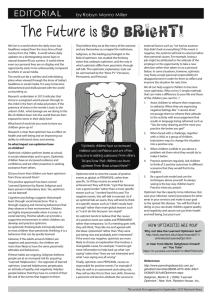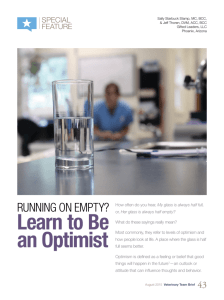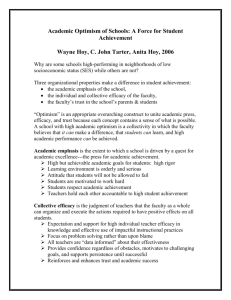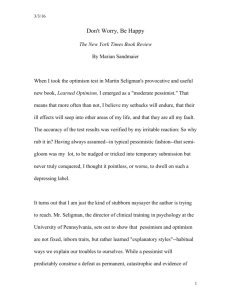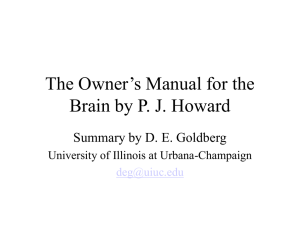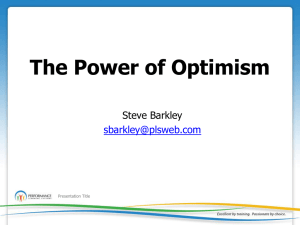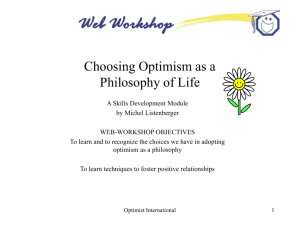Flexible and Accurate Thinking for Optimism
advertisement
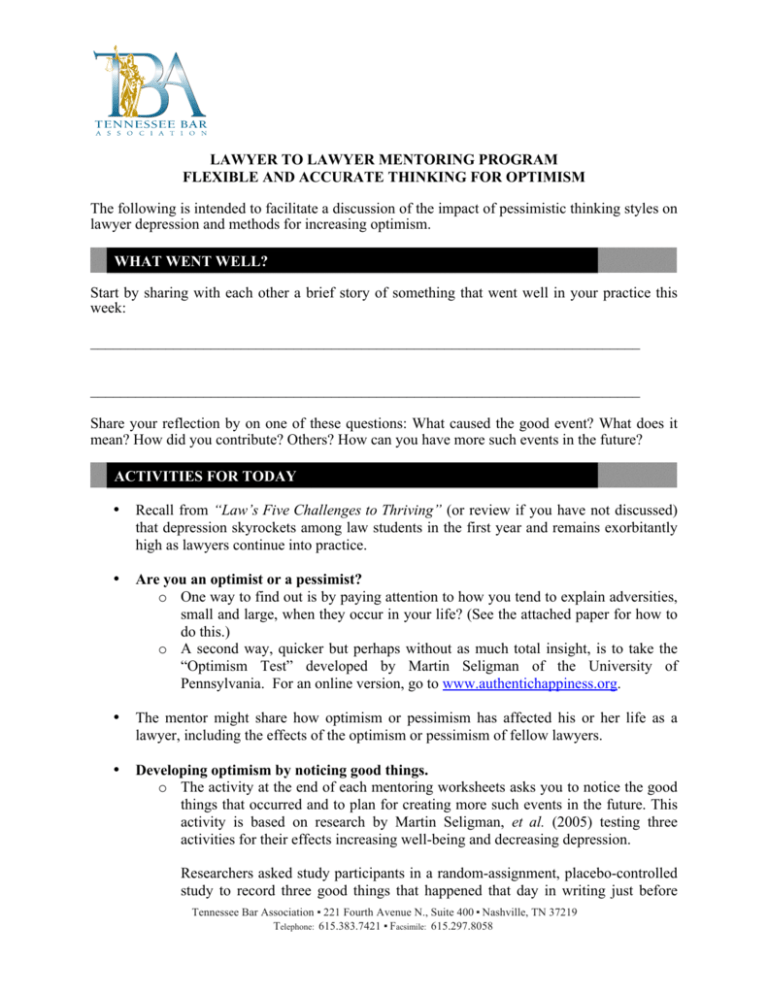
! LAWYER TO LAWYER MENTORING PROGRAM FLEXIBLE AND ACCURATE THINKING FOR OPTIMISM The following is intended to facilitate a discussion of the impact of pessimistic thinking styles on lawyer depression and methods for increasing optimism. WHAT WENT WELL? Start by sharing with each other a brief story of something that went well in your practice this week: _________________________________________________________________________ _________________________________________________________________________ Share your reflection by on one of these questions: What caused the good event? What does it mean? How did you contribute? Others? How can you have more such events in the future? ACTIVITIES FOR TODAY • Recall from “Law’s Five Challenges to Thriving” (or review if you have not discussed) that depression skyrockets among law students in the first year and remains exorbitantly high as lawyers continue into practice. • Are you an optimist or a pessimist? o One way to find out is by paying attention to how you tend to explain adversities, small and large, when they occur in your life? (See the attached paper for how to do this.) o A second way, quicker but perhaps without as much total insight, is to take the “Optimism Test” developed by Martin Seligman of the University of Pennsylvania. For an online version, go to www.authentichappiness.org. • The mentor might share how optimism or pessimism has affected his or her life as a lawyer, including the effects of the optimism or pessimism of fellow lawyers. • Developing optimism by noticing good things. o The activity at the end of each mentoring worksheets asks you to notice the good things that occurred and to plan for creating more such events in the future. This activity is based on research by Martin Seligman, et al. (2005) testing three activities for their effects increasing well-being and decreasing depression. Researchers asked study participants in a random-assignment, placebo-controlled study to record three good things that happened that day in writing just before Tennessee Bar Association ! 221 Fourth Avenue N., Suite 400 ! Nashville, TN 37219 Telephone: 615.383.7421 ! Facsimile: 615.297.8058 ! ! going to bed, then to add a sentence or so of reflection on why the good event happened, its meaning, how they or others contributed to it, and how they good act to have more such good events in the future. Participants were asked to do this for one week, then were followed for six months. The results were startling. Wellbeing (happiness) went up significantly. And depression, even severe cases, dropped significantly. In fact, Dr. Seligman – an expert in the field of depression – characterizes the results as equivalent to the best one could hope for from drugs such as Prozac in the 65% or so of cases where those drugs work, and with only positive side effects such as better sleep! This same skill is taught in the Army’s Comprehensive Soldier Fitness Program as “Hunt the Good Stuff” as a way of developing optimism. It can be done individually, or together with other family members. You might consider trying it for a week and discussing the results. • Do I have what it takes? o Many beginning lawyers (in fact, many people!) ask themselves, “Do I have what it takes?” We can ask this question about our performance as lawyers, spouses, parents or in many other areas of life. Decades of research by Carol Dweck and a team of researchers has shown that this is the wrong question. It assumes that success is based on something we have inside that we cannot see and do not know how much we have of “it.” Whether the “it” is smarts, rainmaking ability, or ability to sustain close, even romantic, relationships, the question itself leaves us constantly doubting ourselves. Even when we are successful, as we undertake ever more challenging goals, we always wonder if tomorrow will be the day we learn we no longer have enough “it.” Dr. Dweck calls this a “fixed” mindset. o Dr. Dweck’s research, however, shows that another large group of people worry very little about having what it takes, because they believe that what it takes is effort, strategy, and knowledge. Since they also believe they can always work harder, develop a better strategy, and gain new knowledge, they effectively see no limit to how successful they can be in any area in which they are truly interested and committed. They have a “growth” mindset. o If your tendency when thinking about success is to ask whether you have “it”, you might want to think about the neuroplasiticity findings in recent years that have shown that the brain continues to develop new connections throughout life. The mind can rewire the brain. Turns out those “growth” mindset folks are the ones truly grounded in reality. o As a mentor leads others, or a beginning lawyer looks toward leadership and considers the kind of leadership he or she is receiving, consider this: praise affects mindset. Multiple studies, from pre-schoolers to seasoned professionals, establish that praise focused on effort, strategy, and knowledge promotes a growth mindset. Praise focused on personal characteristics – “smart” or “talent”– promotes a fixed mindset. Praise yourself and others on effort, strategy, and knowledge. You have to pay more attention to be able to effectively identify the effort, strategy, or knowledge someone brought to bear to achieve a result, but Tennessee Bar Association ! 221 Fourth Avenue N., Suite 400 ! Nashville, TN 37219 Telephone: 615.383.7421 ! Facsimile: 615.297.8058 ! ! you are a much more effective leader when you make that effort and deliver such praise. • Developing Optimism through flexible and accurate thinking… o The attached paper gives a succinct and focused description of a technique for developing realistic optimism by improving the flexibility and accuracy of your thinking. This technique has been studied extensively for decades; has proven useful in ages from middle school to adults, and is currently being taught in the US Army. Discuss the applicability of this technique to your current or past thinking patterns. ACTION STEPS End the session by discussing what action steps you can take to either improve or set yourself up for future success based on today’s discussion. Discuss how one or more of your Signature Strengths can help you achieve success in these steps. _________________________________________________________________________ _________________________________________________________________________ RESOURCES Smart Strengths: A Parent-Teacher-Coach Guide to Building Character, Resilience and Relationships in Youth, (Chapters 7 and 8). Yeager, J., Fisher, S., Shearon, D. (2011). Putnam Valley, NY: Kravis Publishing. Mindset: The new psychology of success. Dweck, C. (2006). New York, NY: Random House. The Resilience Factor: Seven Essential Skills for Overcoming Life's Inevitable Obstacles. Reivich, K., & Shatté, A. (2002). Broadway Books, New York, NY. Learned Optimism. Seligman, M. (1991). Knopf, New York, NY. Seligman, M. E. P., Steen, T. A., Park, N., & Peterson, C. (2005). Positive psychology progress: Empirical validation of interventions. American Psychologist, 60(5), 410-421 Tennessee Bar Association ! 221 Fourth Avenue N., Suite 400 ! Nashville, TN 37219 Telephone: 615.383.7421 ! Facsimile: 615.297.8058 ! The following material is © 2012, David N. Shearon, used by permission: Flexible & Accurate Thinking for Optimism (in a ridiculously small nutshell!) BLUF (Bottom Line Up Front): Your thoughts about your experiences drive your emotions and reactions, not the experiences themselves. You can often improve the flexibility and accuracy of your thoughts and generate more productive emotions and reactions. With practice, you can re-pattern your thinking for better results. ! Activating Event – Any experience that generates an emotion or an action impulse. Thoughts– your heat-of-the moment thoughts or beliefs about an Activating Event, especially causes. Consequences – the emotions and reactions that flow from your beliefs about an AE. AE: Sam walks past his secretary, Carol, as he arrives at his office. She doesn’t look up or speak. Thought: What does Sam think? Write your answer here: Consequences (Emotion/Action): What does Sam feel? How does he tend to react? Write your answer here: Is this typical of how you think and feel about your daily adversities, small and large? In this event, were your Ts and Cs productive or unproductive for you? What about your pattern for such events? Optimism and Pessimism Patterns: Optimists get more of what most of us want, including good health, good friends, and success. The key difference between the two is that when an optimist runs into an adversity, small or large, the optimist’s first thought is that the problem had a short-term, narrow cause and that the optimist is in control. The pessimist’s first thought about adversities, small or large, is that the cause was broad in scope (affecting more than just that event) and long-lasting, maybe permanent. The pessimist does not perceive much opportunity to be in control. Since we all run into multiple bumps in the road almost every day, you can see how the pessimist’s pattern can quickly wear down energy and will power and leave a defeated, dejected, depressed individual. In fact, a mountain of research shows just this: optimistic patterns tend to work, pessimistic patterns produce failure and depression. The good news is that you can change your patterns. Challenge your thoughts. Just because you thought it does not make it true! Use your advocacy skills to generate alternative thoughts. Rebut or mitigate broad, long-lasting, and unchangeable causes for adversities by identifying narrow, short-term causes and areas where you have control or influence. This is not magic. It is work. With work, you can learn to think more flexibly and accurately! Often, this will translate to greater optimism, hope, energy, and engagement1 Think different, feel and act different. Feel and act different – get more of what you want! Notice the pattern of your thoughts –particularly for adversities, small and large for the following dimensions: • • Scope – how many areas of your life does your thought affect? Are you broadly assessing your character or motivation, or the character or motivation of another? If Sam thought, “Something must be bothering Carol this morning,” then he is using a narrow scope that will not cause undue pessimism or depression. If he thinks, “She isn’t talking to me because I’m a loser,” that’s broad – and risky! • Duration – how long will the cause last? If something is bothering Carol, it may not bother her for long. On the other hand, a loser today is a loser tomorrow and on and on. • Control – how much can you control the situation? Although Sam cannot control what is bothering Carol, he can either wait it out, talk to her about it, help her find assistance, or any number of other responses. Being a loser, however, may be something Sam sees as unchangeable. • Pessimistic Thinking – the road to hopelessness, helplessness, and depression! Pessimistic thinking is the tendency to see: o Adversities – causes are broad, long-lasting, unchangeable. o Good Stuff – causes are specific, short-term, and not in our control. • Optimistic Thinking – the road to motivation, goal achievement, health, happiness, and satisfying personal relationships. Optimistic thinking is the tendency to see: o Adversities – causes are specific, short-term, changeable. o Good Stuff – causes are broad, long-lasting, in our control. • Practice can make you a functional optimist. You can become so fluid at noticing any broad, permanent, unchangeable thought about an adversity that you almost immediately identify more narrow, temporary causes and find ways to be in control. Over time, you many find yourself generating the more optimistic explanations as your first thoughts.

